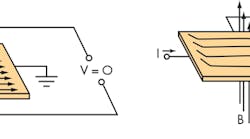Hall-Effect Sensing Makes Sense in Building Automation, Portables (.PDF Download)
The main trends in today’s building automation and personal electronics market include miniaturization and portability, along with increasing intelligence and lower costs. Achieving these trends, however, entails both challenges and tradeoffs. One of the most promising technologies for this market is Hall-effect sensing.
The Hall-effect principle is a popular magnetic sensing technology invented by Edwin Hall in 1879. The principle is simply a differential voltage generated in a current-carrying conductor, usually called a Hall element, when applying a perpendicular magnetic field to the conductor. The voltage is a result of a Lorentz force caused by the applied magnetic field, which causes the current electrons to concentrate in one end of the conductor and generate a potential difference between the two ends.
1. The voltage is usually referred to as a Hall voltage (VH).
Figure 1 illustrates the Hall-effect principle and the relationship between the current, voltage, and magnetic field. The generated voltage is usually referred to as a Hall voltage (VH). When a magnetic field isn’t present, the distribution of current electrons is uniform and VH is zero. When a magnetic field is applied, the distribution of current electrons is disturbed and will result in a non-zero VH proportional to the cross product of the current and the applied magnetic field. The current is usually fixed, resulting in a direct relationship between VH and the applied magnetic field.
VH has a very small value (on the order of few microvolts per volt of the supply voltage used to generate the Hall current per millitesla of the applied magnetic field (µV/Vs/mT). To make this voltage value usable, an amplification stage amplifies the differential voltage and rejects any common-mode signal, which is why you need a differential amplifier for this stage.
Figure 2 presents the typical components of a Hall-effect sensor. Different Hall-effect sensors use the output of the differential amplifier in numerous ways to achieve various functions. For more details about Hall-effect sensors and other magnetic sensor technologies, check out Texas Instruments’ (TI) white paper on the subject.

